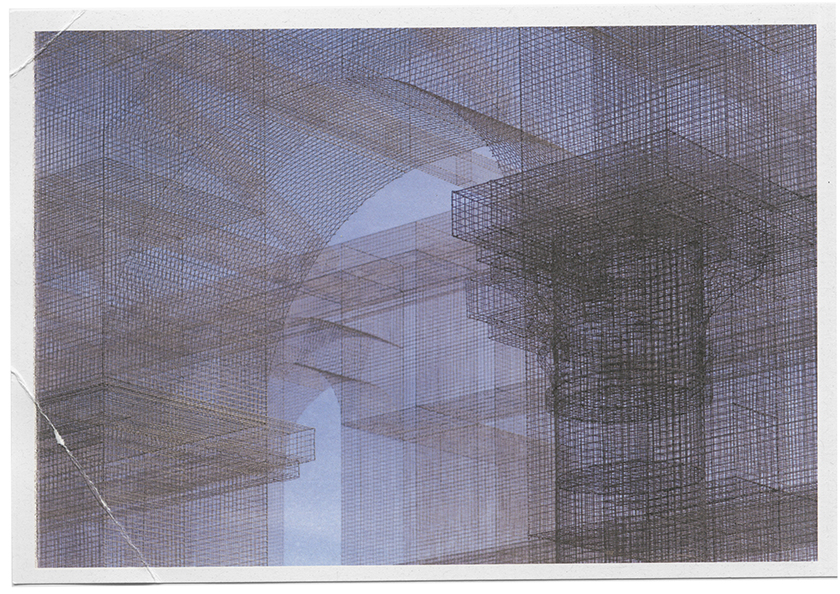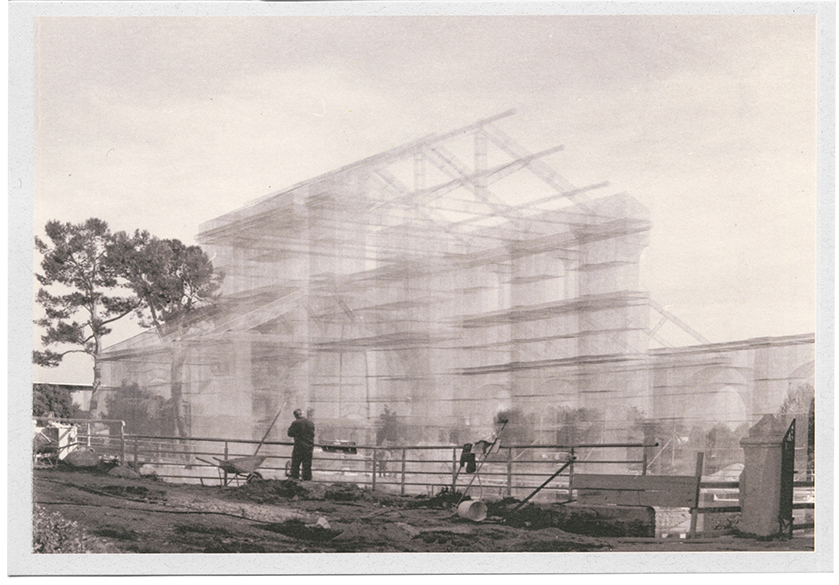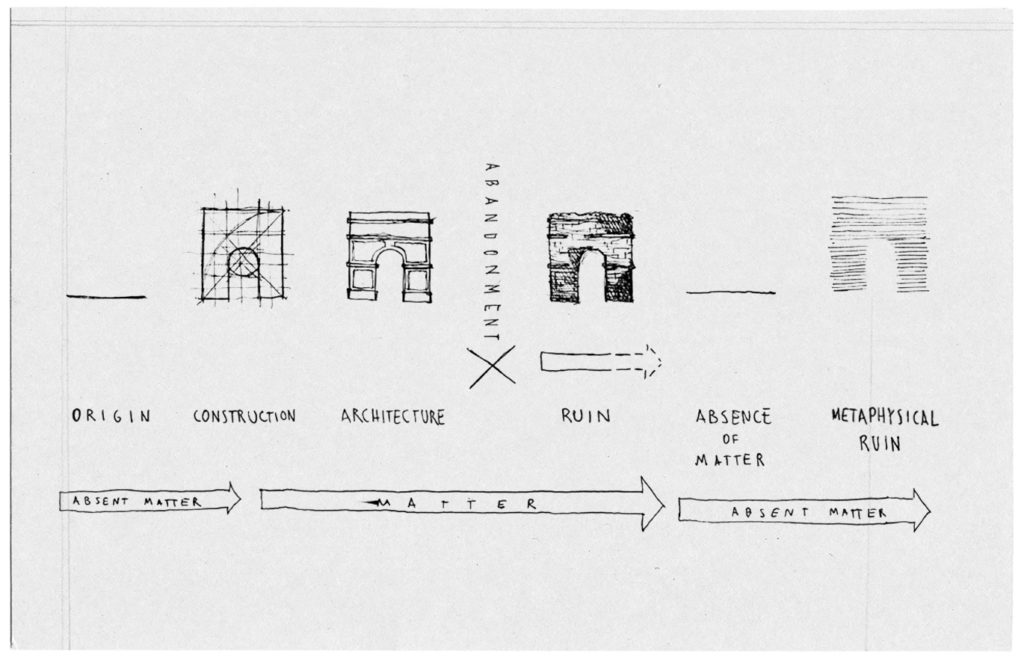ABSENT MATTER

The use of wire mesh and the study of transparency delineate the space of Absent Matter, the representation of a mental projection, a filter and form through which to recount the mutual interfusion of the cultural landscape and the physical environment, both natural and built.
A direct consequence of work in the field that weaves together transparency and the surrounding environment, the theory lays emphasis on a creative will that triggers an ongoing dialogue with space and history, and projects the sculptural object into a new temporal extension: what has faded away, or never existed, lives again in a time that is not its own.
The language that transparency carries with it has the capacity to weave in space something that is not there; it renders the negation of matter plastic and reveals the result of an absence, and hence the abstraction of reality and its visual identity without references in time.
The broken rhythms of transparency generate continual sequences of abstractions and amplified points of view, while light and atmospheric factors shape the way it is read in different situations.
What results are living sculptural works that generate personal and collective experiences which evolve through the elements that form them.
L’utilizzo della rete metallica e lo studio della trasparenza disegnano lo spazio della Materia Assente, la rappresentazione di una proiezione mentale, filtro e forma attraverso cui raccontare la compenetrazione di paesaggio culturale e ambiente fisico, naturale e costruito.
Diretta conseguenza del lavoro sul campo che intreccia trasparenza e ambiente circostante, la teoria pone l’accento su una volontà creativa che innesca dialoghi ininterrotti con lo spazio e la storia ed è in grado di proiettare l’oggetto scultoreo in un’inedita estensione temporale: ciò che è dissolto, o non è mai esistito, rivive in un tempo non suo.
Il linguaggio che la trasparenza porta con sé ha la capacità di tessere nello spazio qualcosa che non c’è, rende plastica la negazione della materia e rivela il risultato di una mancanza, quindi l’astrazione della realtà e la sua identità visiva senza riferimenti nel tempo.
I ritmi spezzati della trasparenza generano continue sequenze di astrazioni e punti di vista amplificati mentre la luce e i fattori atmosferici ne determinano la leggibilità in situazioni sempre diverse.
Nascono opere scultoree, vive, in grado di generare esperienze personali quanto collettive che si evolvono at- traverso gli elementi che le compongono.
THE METAPHYSICAL RUIN

Innate to the development of the concept of Absent Matter and amplified through work with the archaeological dimension, the theory opens up a reflection on the life of architecture and the existential relationship that this creates with the elements of the anthropic and natural landscape.
It is a perspective that positions human endeavour within a living cycle in which nature and architecture alternate and dialogue with each other.
The life cycle of a building envisages various physical states over the course of its existence. In the phases prior to construction, the state of non-matter prevails, a void that humans fill by means of removal for the benefit of the building. Following a traumatic environmental or social change comes abandonment, a phenomenon that begins the dynamic process of the alteration, mutation and decomposition of the building, namely the state of ruin: matter causes the cyclical and inexorable action of nature; it disintegrates and is enriched by its temporal experience. This gradual metamorphosis modifies the whole and slowly leads to the disappearance of the monument, to a state of absence of matter, to an “immaterial find” of what once was and no longer is.
The concept of Metaphysical Ruin is bound up with the language of transparency pertaining to Absent Matter, offering the viewer a new experience of temporal mutual interfusion between past and present, one that is distinct from mere contemplation of the ruin.
Coming into play, then, is a further stage of the architectural life cycle, which narrates the volumes and languages of the original architecture, rekindles memory and intermingles with the contemporary landscape and the surrounding context.
Connaturata allo sviluppo del concetto di Materia Assente e ampliata attraverso il lavoro con l’archeologia, la teoria apre una riflessione sulla vita dell’architettura e sul rapporto esistenziale che questa instaura con gli elementi del paesaggio antropico e naturale.
Una visione che colloca il lavoro dell’uomo all’interno di un ciclo vitale in cui natura e architettura si avvicendano e dialogano.
Il ciclo di vita di una architettura contempla più stati fisici nell’arco della sua esistenza. Nelle fasi precedenti alla costruzione vige lo stato di non materia, un vuoto che l’uomo riempie per sottrazione a vantaggio dell’architettura. In seguito ad un cambiamento traumatico ambientale o sociale subentra l’abbandono, un fenomeno che avvia il processo dinamico di alterazione, mutazione e decomposizione del fabbricato, ossia lo stato di rovina: la materia causa l’azione ciclica e inesorabile della natura, si disgrega e si arricchisce del suo vissuto temporale. Questa graduale metamorfosi ne modifica l’insieme e conduce lentamente il monumento alla sparizione, ad uno stato di assenza di materia, un “reperto immateriale” di ciò che era e non è più.
Il concetto di Rovina Metafisica si salda al linguaggio della trasparenza, proprio della Materia Assente, proponendo al fruitore una nuova esperienza di compenetrazione temporale, fra passato e presente, distinta dalla mera contemplazione della rovina.
Entra quindi in gioco un ulteriore stadio del ciclo vitale architettonico che racconta gli ingombri e i linguaggi dell’architettura originaria, riaccende la memoria, si contamina con il paesaggio contemporaneo e il contesto circostante.
